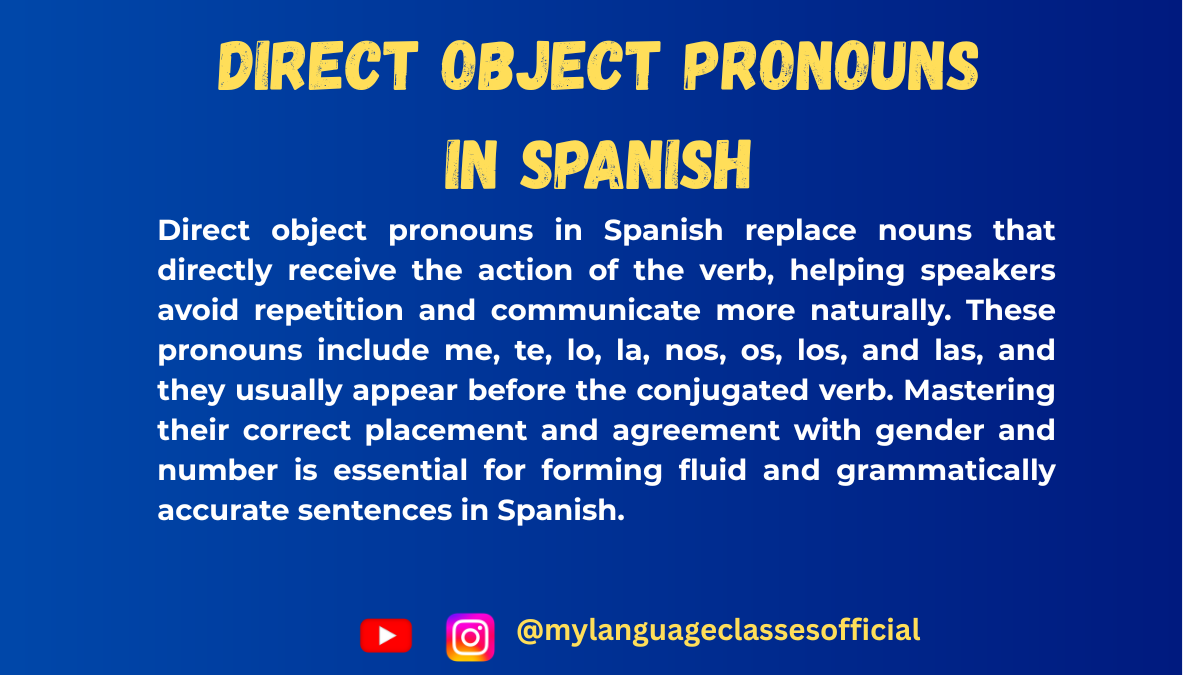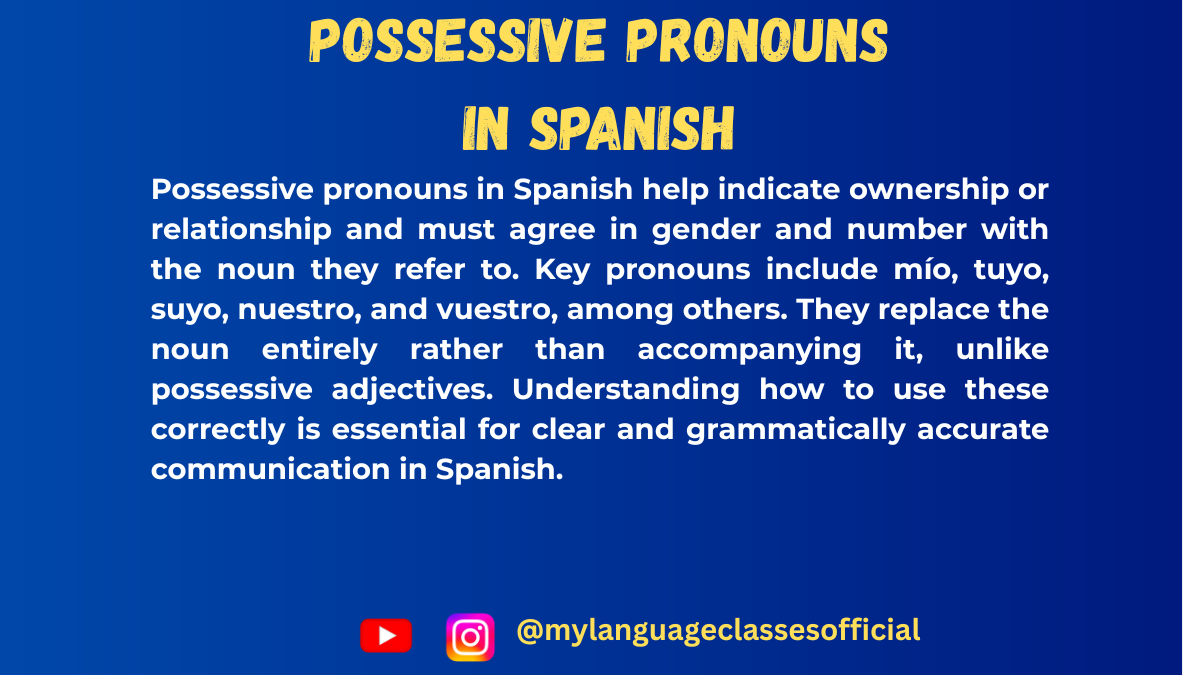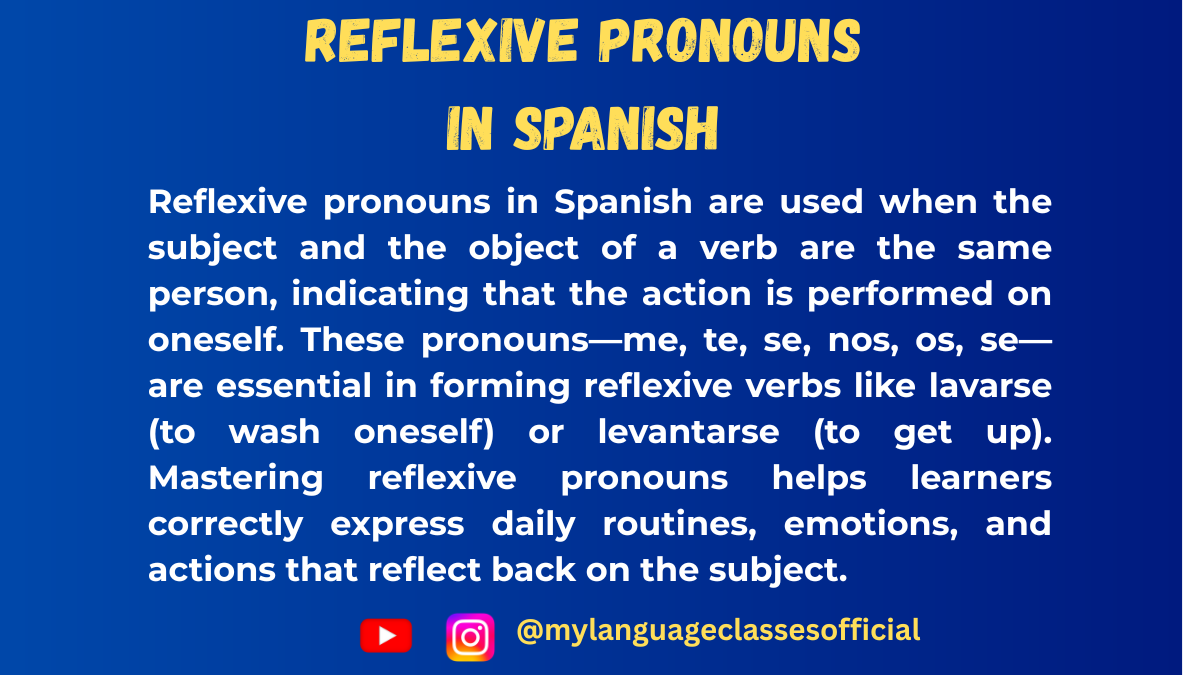Your cart is currently empty!
Category: Pronouns in Spanish
Learn all about Spanish pronouns—subject, object, reflexive, possessive, and more. Understand how to use them correctly in different contexts with clear explanations, grammar rules, and example sentences. Perfect for beginner to advanced Spanish learners aiming to speak and write more naturally.
-
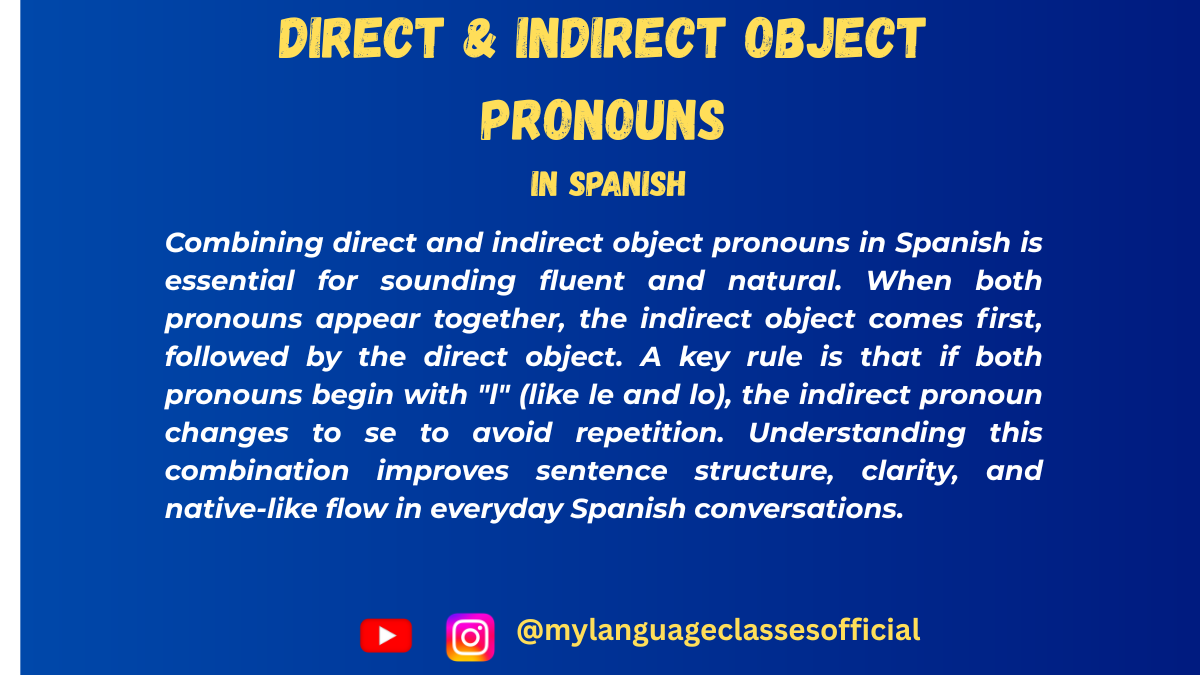
Indirect & Direct Object Pronouns Combined in Spanish Grammar
Mastering Spanish pronouns can be challenging, especially when both indirect and direct object pronouns are used together in a sentence. In this comprehensive guide, we will explore how to combine these pronouns correctly, following grammar rules, common expressions, usage scenarios, and conjugations. By the end, you’ll be able to construct natural-sounding Spanish sentences with confidence!
Common Expressions Using Indirect & Direct Object Pronouns Combined
Here are some commonly used expressions in Spanish where both pronouns appear together:
Spanish Expression English Meaning Te lo dije. I told you (it). Me lo das. You give it to me. Se lo presté. I lent it to him/her. Nos lo explicó. He/She explained it to us. Se lo mandaron. They sent it to him/her. Me lo contaron. They told me (about it). Te la enseño. I show it to you. Se lo compré. I bought it for him/her. Nos lo devolvieron. They returned it to us. Me la dio. He/She gave it to me.
Grammar Rules
To correctly use indirect and direct object pronouns together in Spanish, follow these essential grammar rules:
1. Order of Pronouns
The indirect object pronoun (IOP) always comes before the **direct object pronoun (DOP):
- Subject + IOP + DOP + VerbExample: Te lo dije. (I told you it.)
2. Pronoun Placement
- Before a conjugated verb: Me lo dieron. (They gave it to me.)
- Attached to an infinitive or gerund: Voy a dártelo. (I’m going to give it to you.)
- Attached to a command:
- Affirmative: Dámelo. (Give it to me.)
- Negative: No me lo des. (Don’t give it to me.)
3. Pronoun Changes
- When le or les (indirect object pronouns) are followed by lo, la, los, or las (direct object pronouns), le/les changes to se to avoid repetition.Example: Le lo di ❌ → Se lo di ✅ (I gave it to him/her.)
4. Agreement with Gender and Number
- The direct object pronoun must match the gender and number of the noun it replaces.Examples:
- Me la dio. (He gave it to me. – referring to “la carta.”)
- Nos los enviaron. (They sent them to us. – referring to “los paquetes.”)
When to Use Indirect & Direct Object Pronouns Combined
Here are different situations where both pronouns are commonly used:
1. Expressing Actions Performed for Someone
- Se lo compré. (I bought it for him/her.)
- Te lo mandaré. (I will send it to you.)
2. Reporting Information
- Me lo contaron. (They told me about it.)
- Nos lo explicó. (He explained it to us.)
3. Giving and Receiving Objects
- Me la dio. (He gave it to me.)
- Se lo devolvieron. (They returned it to him/her.)
Conjugation
When using Indirect and Direct Object Pronouns together in Spanish, the indirect object pronoun always comes before the direct object pronoun. The order follows this pattern:
Indirect Object Pronoun (IOP) + Direct Object Pronoun (DOP) + Conjugated Verb
1. Conjugation of Regular Verbs with Indirect & Direct Object Pronouns Combined
Regular verbs follow predictable patterns based on their endings:
- AR verbs (hablar, comprar, llamar)
- ER verbs (comer, aprender, vender)
- IR verbs (vivir, escribir, recibir)
Present Tense Example:
Verb Without Pronouns With Pronouns (le/les → se) + English Translation Hablar (to speak) Yo hablo el español a María. Yo se lo hablo. (I speak it to her.) Comprar (to buy) Yo compro la camisa para ti. Yo te la compro. (I buy it for you.) Vender (to sell) Él vende el coche a Juan. Él se lo vende. (He sells it to him.) Preterite Tense Example:
Verb Without Pronouns With Pronouns + English Translation Llamar (to call) Yo llamé a mi madre. Yo se la llamé. (I called her.) Aprender (to learn) Nosotros aprendimos la lección de ella. Nosotros se la aprendimos. (We learned it from her.) Escribir (to write) Él escribió la carta a su amigo. Él se la escribió. (He wrote it to him.)
2. Conjugation of Irregular Verbs with Indirect & Direct Object Pronouns Combined
Some irregular verbs change their stems or conjugation patterns. Here are common irregular verbs and how they work with combined object pronouns:
Common Irregular Verbs with Indirect & Direct Object Pronouns
Verb Meaning Example Sentence + English Translation Dar (to give) Yo le di el libro a Juan. Yo se lo di. (I gave it to him.) Decir (to say/tell) Ella le dijo la verdad a Pedro. Ella se la dijo. (She told it to him.) Hacer (to do/make) Ellos me hicieron un favor. Ellos me lo hicieron. (They did it for me.) Poner (to put) Él te puso la chaqueta. Él te la puso. (He put it on you.) Traer (to bring) Yo le traje los documentos a Ana. Yo se los traje. (I brought them to her.)
Example Sentences with Irregular Verbs:
- Te la dije ayer. (I told it to you yesterday.) → From decir
- Se lo hicieron con mucho esfuerzo. (They did it for him/her with a lot of effort.) → From hacer
- Nos los trajeron temprano. (They brought them to us early.) → From traer
- Me lo pusiste en la mesa. (You placed it on the table for me.) → From poner
- Se la dimos en la mañana. (We gave it to them in the morning.) → From dar
Things to Keep in Mind
When using Indirect and Direct Object Pronouns together in Spanish, there are some important rules and exceptions to watch out for. Below are the key things to keep in mind:
1. Le & Les Change to “Se” When Followed by Lo, La, Los, or Las
- If the indirect object pronoun (le or les) is followed by a direct object pronoun (lo, la, los, or las), the le/les changes to se to avoid tongue-twisting sounds.
❌ Incorrect: Le lo dije.
✅ Correct: Se lo dije. (I told it to him.)❌ Incorrect: Les las di.
✅ Correct: Se las di. (I gave them to them.)
2. Clarifying “Se” to Avoid Ambiguity
- Since “se” can replace le or les, it might be unclear who “se” refers to. To clarify, you can add “a él,” “a ella,” “a ellos,” or “a ellas.”
✅ Se lo dije a Juan. (I told it to Juan.)
✅ Se los envié a mis amigos. (I sent them to my friends.)
3. Placement of Pronouns in a Sentence
Spanish allows for different placements of combined object pronouns based on the verb form.
A. Before a Conjugated Verb
✅ Te lo doy. (I give it to you.)
✅ Se lo contamos. (We tell it to him/her.)B. Attached to an Infinitive
✅ Voy a dártelo. (I am going to give it to you.)
✅ Quiero explicárselo. (I want to explain it to him/her.)C. Attached to a Gerund (Present Participle -iendo/-ando)
✅ Estoy dándotelo. (I am giving it to you.)
✅ Está explicándoselo. (He/She is explaining it to them.)📌 Note: When attaching pronouns to gerunds or infinitives, an accent mark is added to maintain the correct pronunciation.
❌ Incorrect: Estoy dantelo.
✅ Correct: Estoy dándotelo.
4. Order of Pronouns is Fixed: IOP Always Comes Before DOP
- You cannot swap the order of pronouns.
❌ Lo me dio.
✅ Me lo dio. (He/She gave it to me.)
5. Commands Change the Position of Pronouns
A. Affirmative Commands – Attach Pronouns to the End
✅ Dímelo. (Tell it to me.)
✅ Dáselo. (Give it to him/her.)
✅ Explícamelo. (Explain it to me.)📌 Note: With commands, add an accent mark if needed to maintain the correct stress.
❌ Incorrect: Dimelo.
✅ Correct: Dímelo.B. Negative Commands – Place Pronouns Before the Verb
✅ No me lo digas. (Don’t tell it to me.)
✅ No se lo des. (Don’t give it to him/her.)
6. Using Double Object Pronouns in Reflexive Verbs
- When a verb is reflexive, the reflexive pronoun (me, te, se, nos) still comes before the indirect and direct object pronouns.
✅ Me lo lavo. (I wash it for myself.)
✅ Te lo pusiste. (You put it on yourself.)
✅ Se lo compró. (He/She bought it for himself/herself.)
7. Using Indirect & Direct Object Pronouns with “Gustar” and Similar Verbs
- Verbs like gustar, encantar, molestar, interesar, importar always use an indirect object pronoun, but you generally don’t use a direct object pronoun with them.
❌ Incorrect: Me lo gusta.
✅ Correct: Me gusta. (I like it.)However, if you’re referring to liking something specific that has already been mentioned, you can use both pronouns:
✅ Me lo gusta cuando me cocinas. (I like it when you cook for me.)
8. No Redundancy in Object Pronouns
- Unlike some other languages, Spanish does not allow redundancy in direct and indirect object pronouns.
❌ Incorrect: A Juan le lo di.
✅ Correct: A Juan se lo di. (I gave it to Juan.)
9. Double Object Pronouns with Questions & Answers
When responding to a question, Spanish often replaces nouns with double object pronouns:
❓ ¿Me das la llave? (Can you give me the key?)
✅ Sí, te la doy. (Yes, I give it to you.)❓ ¿Nos traes los papeles? (Can you bring us the papers?)
✅ Sí, se los traigo. (Yes, I bring them to you all.)
10. Indirect Object Pronoun is Required Even if the Indirect Object is Explicit
- In Spanish, you must use an indirect object pronoun even if the actual indirect object (person) is mentioned.
✅ Le di el libro a Juan. (I gave the book to Juan.)
✅ Les envié el paquete a mis amigos. (I sent the package to my friends.)❌ Incorrect: Di el libro a Juan. (Missing le)
❌ Incorrect: Envié el paquete a mis amigos. (Missing les)
Final Recap
- Le/les → se before lo/la/los/las.
- Indirect Object Pronoun (IOP) always comes first before Direct Object Pronoun (DOP).
- Pronoun placement changes in affirmative commands, negative commands, infinitives, and gerunds.
- Reflexive verbs follow the same pronoun order.
- Clarify “se” by adding “a + name/person” if needed.
- Indirect Object Pronoun is required even when the noun is stated.
By keeping these rules in mind, you’ll avoid common mistakes and sound more natural in Spanish!
Example Table
Sentence in Spanish English Translation Se lo dije ayer. I told it to him/her yesterday. Te la envié por correo. I sent it to you by mail. Nos los dieron en la reunión. They gave them to us in the meeting. Se las compré a mis hijos. I bought them for my kids. Me lo explicaron en clase. They explained it to me in class. Se lo presté a mi amigo. I lent it to my friend. Me los devolvieron la semana pasada. They returned them to me last week. Se la recomendaron a Juan. They recommended it to Juan. Te lo prometí, y aquí está. I promised it to you, and here it is. Se lo trajimos de España. We brought it to him/her from Spain. Nos las mostraron en el museo. They showed them to us in the museum. Me la pidió antes de salir. He/She asked me for it before leaving. Te los guardé en la caja. I kept them for you in the box. Se la cociné con mucho amor. I cooked it for him/her with a lot of love. Se lo contamos todo. We told it all to him/her.
More Example Sentences
- Se lo expliqué varias veces. (I explained it to him/her several times.)
- Me la devolviste en perfecto estado. (You returned it to me in perfect condition.)
- Te los compré porque sé que te gustan. (I bought them for you because I know you like them.)
- Nos la enviaron por correo urgente. (They sent it to us by urgent mail.)
- Se los vendimos a buen precio. (We sold them to him/her at a good price.)
- Me lo recordaste en el último momento. (You reminded me of it at the last moment.)
- Te la mostré en mi teléfono. (I showed it to you on my phone.)
- Se lo pedimos amablemente. (We asked him/her for it politely.)
- Nos lo dijeron en secreto. (They told it to us in secret.)
- Me las prestaste la semana pasada. (You lent them to me last week.)
Exercise
Fill in the blanks with the correct Indirect & Direct Object Pronouns Combined in Spanish.
- Yo ___ ___ di ayer. (I gave it to you yesterday.)
- Ellos ___ ___ explicaron en detalle. (They explained it to us in detail.)
- ¿Tú ___ ___ compraste en la tienda? (Did you buy it for him/her at the store?)
- Nosotros ___ ___ trajimos de México. (We brought them to you from Mexico.)
- ¿Quién ___ ___ envió por correo? (Who sent it to them by mail?)
- Ella ___ ___ pidió prestado. (She borrowed it from me.)
- Juan ___ ___ mostró en su computadora. (Juan showed it to us on his computer.)
- Yo ___ ___ recordé esta mañana. (I reminded him/her about it this morning.)
- Ellos ___ ___ vendieron a buen precio. (They sold them to him/her at a good price.)
- ¿Tú ___ ___ prestaste para la reunión? (Did you lend it to me for the meeting?)
Answers
- Yo te lo di ayer. (I gave it to you yesterday.)
- Ellos nos lo explicaron en detalle. (They explained it to us in detail.)
- ¿Tú se lo compraste en la tienda? (Did you buy it for him/her at the store?)
- Nosotros te los trajimos de México. (We brought them to you from Mexico.)
- ¿Quién se lo envió por correo? (Who sent it to them by mail?)
- Ella me lo pidió prestado. (She borrowed it from me.)
- Juan nos lo mostró en su computadora. (Juan showed it to us on his computer.)
- Yo se lo recordé esta mañana. (I reminded him/her about it this morning.)
- Ellos se los vendieron a buen precio. (They sold them to him/her at a good price.)
- ¿Tú me lo prestaste para la reunión? (Did you lend it to me for the meeting?)
Conclusion
Mastering Indirect & Direct Object Pronouns Combined in Spanish is essential for achieving fluency and sounding more natural in conversations. While the rules may seem tricky at first—especially when dealing with “se” replacing “le/les,” pronoun placement, and command structures—consistent practice will make them second nature.
By carefully studying the rules, exceptions, and examples covered in this blog, you can start incorporating these pronouns seamlessly into your speech and writing. The exercises provided will help reinforce your understanding, so be sure to practice regularly.
Keep experimenting with different sentence structures, and don’t hesitate to immerse yourself in Spanish content to see these pronouns in action. With time, you’ll gain confidence in using them effortlessly in real conversations.
¡Sigue practicando y mejorarás rápidamente! (Keep practicing, and you’ll improve quickly!)
If you enjoyed this lesson, be sure to check out more posts like this on my blog at My Language Classes. Don’t forget to subscribe my YouTube channel and follow me on Instagram for the latest language learning tips and lessons. Leave a comment below to share your thoughts, or ask any questions you have about nouns.
Happy learning! 😊
📚 Continue Learning Spanish
-
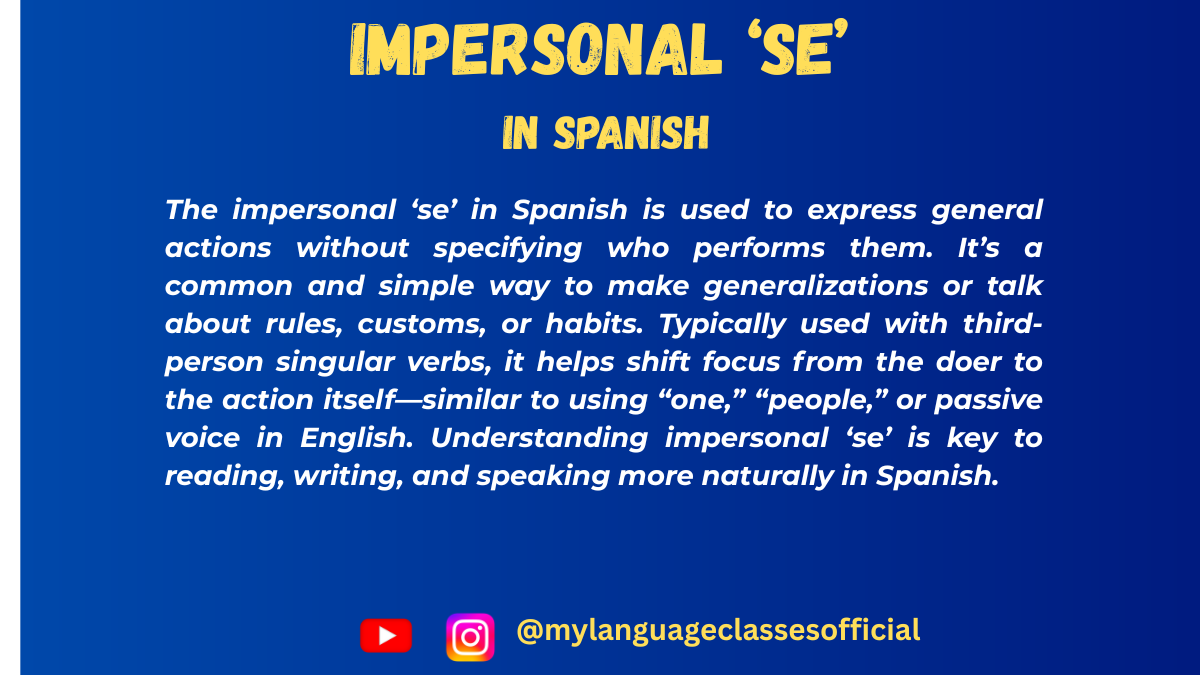
Impersonal “Se” in Spanish Grammar
The impersonal “se” is a crucial aspect of Spanish grammar that allows speakers to express general statements without specifying a subject. It is commonly used in formal speech, instructions, advertisements, and everyday conversation. Understanding impersonal “se” enhances fluency and helps learners sound more natural in Spanish.
This guide will explore the meaning, usage, rules, and examples of impersonal “se” with structured explanations, tables, and exercises.
Common Expressions Using Impersonal “Se”
Here are some common daily expressions using impersonal “se” in Spanish:
- Se habla español. (Spanish is spoken here.)
- Se dice que va a llover. (It is said that it will rain.)
- Se busca camarero. (Waiter wanted.)
- No se permite fumar. (Smoking is not allowed.)
- Se necesita ayuda. (Help is needed.)
- Se vive bien aquí. (One lives well here.)
- Se recomienda paciencia. (Patience is recommended.)
- Se come bien en este restaurante. (People eat well in this restaurant.)
- Se venden coches aquí. (Cars are sold here.)
- Se aprende mucho en esta escuela. (One learns a lot in this school.)
Grammar Rules
How “Se” Works in Impersonal Sentences
- Impersonal “se” is used with third-person singular verbs.
- It does not refer to a specific subject.
- It is often followed by an infinitive or a noun.
- When followed by a plural noun, the verb agrees in plural form.
Common Sentence Structures
Singular Form:
- Se necesita paciencia. (Patience is needed.)
- Se cree que ella es honesta. (It is believed that she is honest.)
Plural Form:
- Se venden frutas frescas. (Fresh fruits are sold.)
- Se contratan empleados nuevos. (New employees are hired.)
When to Use Impersonal “Se”
1. General Statements
Used when making general claims without specifying a subject.
- Se dice que la ciudad es hermosa. (It is said that the city is beautiful.)
- Se piensa que es una buena idea. (It is thought to be a good idea.)
2. Rules & Prohibitions
Used in warnings, rules, or public signs.
- No se permite fumar aquí. (Smoking is not allowed here.)
- Se prohíbe el acceso sin autorización. (Access is prohibited without authorization.)
3. Passive Voice Alternative
Used instead of passive voice for natural-sounding Spanish.
- Se construyó la casa en 1990. (The house was built in 1990.)
- Se ha cambiado la dirección. (The address has been changed.)
4. Unspecified Subjects
Used when referring to people in general.
- Se come bien en México. (People eat well in Mexico.)
- Se duerme mejor con una buena almohada. (One sleeps better with a good pillow.)
Conjugation
Regular Verbs
Verb Infinitive Impersonal Form Hablar Hablar Se habla español. Comer Comer Se come bien aquí. Vivir Vivir Se vive en paz. Irregular Verbs
Verb Infinitive Impersonal Form Decir Decir Se dice la verdad. Hacer Hacer Se hace el trabajo rápidamente. Ver Ver Se ve el mar desde aquí.
Things to Keep in Mind
- “Se” is always used with third-person singular or plural verbs.
- It does not refer to a specific subject.
- When a plural noun follows, use a plural verb.
Example Table
Example Sentence (Spanish) English Translation Se vende pan fresco. Fresh bread is sold. Se aprende rápido. One learns quickly. Se busca profesor de inglés. An English teacher is wanted. Se necesita ayuda. Help is needed. Se prohíbe la entrada. Entry is prohibited. Se recomienda paciencia. Patience is recommended. Se vive bien en esta ciudad. One lives well in this city. Se come mejor aquí. One eats better here. Se trabaja mejor con buena luz. One works better with good lighting. Se dice que es un buen país. It is said that it is a good country. Se piensa que lloverá mañana. It is thought that it will rain tomorrow. Se llega temprano a la escuela. One arrives early at school. Se habla rápido en algunas regiones. People speak fast in some regions. Se duerme mejor con una manta. One sleeps better with a blanket. Se trabaja bien bajo presión. One works well under pressure.
More Example Sentences
- Se alquilan apartamentos cerca de la playa. (Apartments for rent near the beach.)
- Se recomienda leer antes de dormir. (Reading before sleeping is recommended.)
- Se come paella en España. (People eat paella in Spain.)
- Se necesita paciencia para aprender un idioma. (Patience is needed to learn a language.)
- Se buscan voluntarios para el evento. (Volunteers are wanted for the event.)
- Se ve mejor desde aquí. (It is seen better from here.)
- Se trabaja mejor con buena luz. (One works better with good lighting.)
- Se aprende rápido con práctica. (One learns quickly with practice.)
- Se habla francés en Canadá. (French is spoken in Canada.)
- Se dice que el clima cambiará pronto. (It is said that the weather will change soon.)
Exercise
Fill in the blanks with the correct form using the impersonal “se.”
- _______ (hablar) español en muchos países del mundo.
- _______ (comer) mucha paella en Valencia.
- _______ (prohibir) fumar en lugares públicos.
- _______ (vender) ropa de alta calidad en esta tienda.
- _______ (necesitar) experiencia para este trabajo.
- _______ (usar) demasiado plástico en el mundo.
- _______ (ver) muchas películas extranjeras en este cine.
- _______ (recomendar) hacer ejercicio todos los días.
- _______ (decir) que el desayuno es la comida más importante del día.
- _______ (aprender) español fácilmente con práctica diaria.
Answers:
- Se habla español en muchos países del mundo. (Spanish is spoken in many countries around the world.)
- Se come mucha paella en Valencia. (A lot of paella is eaten in Valencia.)
- Se prohíbe fumar en lugares públicos. (Smoking is prohibited in public places.)
- Se vende ropa de alta calidad en esta tienda. (High-quality clothing is sold in this store.)
- Se necesita experiencia para este trabajo. (Experience is needed for this job.)
- Se usa demasiado plástico en el mundo. (Too much plastic is used in the world.)
- Se ven muchas películas extranjeras en este cine. (Many foreign movies are watched in this cinema.)
- Se recomienda hacer ejercicio todos los días. (It is recommended to exercise every day.)
- Se dice que el desayuno es la comida más importante del día. (It is said that breakfast is the most important meal of the day.)
- Se aprende español fácilmente con práctica diaria. (Spanish is learned easily with daily practice.)
Conclusion
Mastering the impersonal “se” helps Spanish learners communicate effectively and naturally. This structure is essential in everyday speech, formal writing, and professional settings. By practicing and using the impersonal “se” in real-life situations, you can enhance your fluency and sound more like a native speaker.
Keep practicing, and soon, using “se” will become second nature!
If you enjoyed this lesson, be sure to check out more posts like this on my blog at My Language Classes. Don’t forget to subscribe my YouTube channel and follow me on Instagram for the latest language learning tips and lessons. Leave a comment below to share your thoughts, or ask any questions you have about nouns.
Happy learning! 😊
📚 Continue Learning Spanish
-

Mastering the Passive Reflexive ‘Se’ in Spanish
The passive reflexive ‘se’ is one of the most versatile and commonly used constructions in the Spanish language. It allows speakers to express actions in a way that emphasizes the action itself rather than who is performing it. This structure is particularly useful when the subject is unknown, irrelevant, or generalized. For example, instead of saying “Someone sells fruits here,” you can say “Se venden frutas aquí,” which translates to “Fruits are sold here.”
Understanding the passive reflexive ‘se’ is essential for achieving fluency in Spanish, as it appears frequently in both spoken and written language.
In this blog post, we’ll explore its usage, conjugation, common expressions, and everything you need to know to master this grammatical structure.
Common Expressions Using Passive Reflexive
The passive reflexive ‘se’ is used in many everyday expressions. Here’s a list of common ones:
- Se habla español – Spanish is spoken.
- Se venden casas – Houses are sold.
- Se necesita ayuda – Help is needed.
- Se prohíbe fumar – Smoking is prohibited.
- Se permite estacionar – Parking is allowed.
- Se dice que… – It is said that…
- Se recomienda reservar – It is recommended to book.
- Se ofrecen clases – Classes are offered.
- Se busca empleado – Employee wanted.
- Se alquila apartamento – Apartment for rent.
These expressions are widely used in signs, advertisements, and general conversation.
Things to Keep in Mind
When using the passive reflexive ‘se,’ there are a few key points to remember:
- Articles and Agreement: The verb must agree in number (singular or plural) with the subject. For example:
- Se vende la casa (The house is sold) – Singular.
- Se venden las casas (The houses are sold) – Plural.
- Gender Agreement: While the verb doesn’t change for gender, the noun or adjective accompanying it does. For example:
- Se venden camisas rojas (Red shirts are sold).
- No Specific Subject: The passive reflexive ‘se’ is used when the subject performing the action is either unknown or unimportant.
- Avoiding Redundancy: Unlike English, Spanish often omits the subject entirely when using the passive reflexive. For example, instead of saying “Se venden las manzanas por alguien” (Apples are sold by someone), simply say “Se venden las manzanas.”
When to Use the Passive Reflexive ‘Se’
The passive reflexive ‘se’ is used in the following situations:
- General Statements: When making broad or general statements.
- Se come bien en México (People eat well in Mexico).
- Impersonal Actions: When the subject is unknown or irrelevant.
- Se construyó este edificio en 1990 (This building was built in 1990).
- Instructions or Warnings: In signs, manuals, or public notices.
- Se prohíbe el paso (No entry allowed).
- Advertising or Offers: To promote products or services.
- Se venden coches usados (Used cars for sale).
Conjugation of Regular Verbs in Passive Reflexive
The passive reflexive ‘se’ is formed by combining the pronoun ‘se’ with the third-person singular or plural form of the verb, depending on the subject. Here’s how it works for regular verbs:
1. -AR Verbs
- Hablar (to speak): Se habla / Se hablan
- Se habla español aquí (Spanish is spoken here).
- Se hablan muchos idiomas (Many languages are spoken).
2. -ER Verbs
- Vender (to sell): Se vende / Se venden
- Se vende la casa (The house is sold).
- Se venden libros (Books are sold).
3. -IR Verbs
- Abrir (to open): Se abre / Se abren
- Se abre la tienda a las 9 (The store opens at 9).
- Se abren las ventanas (The windows are opened).
Irregular Verbs and Their Conjugation
Some irregular verbs also follow the passive reflexive structure. Here are a few examples:
- Hacer (to do/make): Se hace / Se hacen
- Se hace el trabajo (The work is done).
- Se hacen pasteles (Cakes are made).
- Decir (to say): Se dice / Se dicen
- Se dice que es verdad (It is said to be true).
- Se dicen muchas cosas (Many things are said).
- Poner (to put): Se pone / Se ponen
- Se pone la mesa (The table is set).
- Se ponen los libros aquí (The books are put here).
10 Regular Verbs in Passive Reflexive Form
Verb Example Sentence 1 Example Sentence 2 Hablar Se habla español aquí. (Spanish is spoken here.) Se hablan muchos idiomas. (Many languages are spoken.) Vender Se vende la casa. (The house is sold.) Se venden coches usados. (Used cars are sold.) Abrir Se abre la puerta. (The door is opened.) Se abren las ventanas. (The windows are opened.) Comer Se come bien en este restaurante. (People eat well at this restaurant.) Se comen las manzanas. (The apples are eaten.) Escribir Se escribe una carta. (A letter is written.) Se escriben libros interesantes. (Interesting books are written.) Leer Se lee el periódico. (The newspaper is read.) Se leen muchos libros. (Many books are read.) Cerrar Se cierra la tienda. (The store is closed.) Se cierran las ventanas. (The windows are closed.) Comprar Se compra pan fresco. (Fresh bread is bought.) Se compran regalos. (Gifts are bought.) Limpiar Se limpia la casa. (The house is cleaned.) Se limpian los platos. (The dishes are cleaned.) Usar Se usa el teléfono. (The phone is used.) Se usan computadoras. (Computers are used.)
More Example Sentences
- Se venden flores en el mercado. (Flowers are sold at the market.)
- Se necesita paciencia. (Patience is needed.)
- Se construyen casas nuevas. (New houses are built.)
- Se habla mucho de política. (Politics is talked about a lot.)
- Se permite nadar aquí. (Swimming is allowed here.)
- Se ofrecen descuentos. (Discounts are offered.)
- Se busca un perro perdido. (A lost dog is being searched for.)
- Se alquilan bicicletas. (Bicycles are rented.)
- Se recomienda llegar temprano. (It is recommended to arrive early.)
- Se dice que va a llover. (It is said that it will rain.)
Fill in the Blanks
- Se _______ (vender) frutas en el mercado.
- Se _______ (necesitar) más tiempo.
- Se _______ (hablar) español en Argentina.
- Se _______ (permitir) estacionar aquí.
- Se _______ (construir) un nuevo edificio.
- Se _______ (ofrecer) clases de yoga.
- Se _______ (buscar) un gato perdido.
- Se _______ (alquilar) coches baratos.
- Se _______ (recomendar) leer este libro.
- Se _______ (decir) que es verdad.
Answers:
- venden
- necesita
- habla
- permite
- construye
- ofrecen
- busca
- alquilan
- recomienda
- dice
Conclusion
The passive reflexive ‘se’ is a powerful and versatile tool in Spanish that allows you to express actions in a clear and concise manner. By mastering its usage, conjugation, and common expressions, you’ll be able to communicate more effectively and naturally in Spanish. Whether you’re reading signs, giving instructions, or making general statements, the passive reflexive ‘se’ will undoubtedly enhance your language skills.
Practice regularly, pay attention to agreement rules, and soon you’ll find yourself using this construction with confidence.
¡Buena suerte! (Good luck!)
If you enjoyed this lesson, be sure to check out more posts like this on my blog at My Language Classes. Don’t forget to subscribe my YouTube channel and follow me on Instagram for the latest language learning tips and lessons. Leave a comment below to share your thoughts, or ask any questions you have about nouns.
Happy learning! 😊
📚 Continue Learning Spanish
-
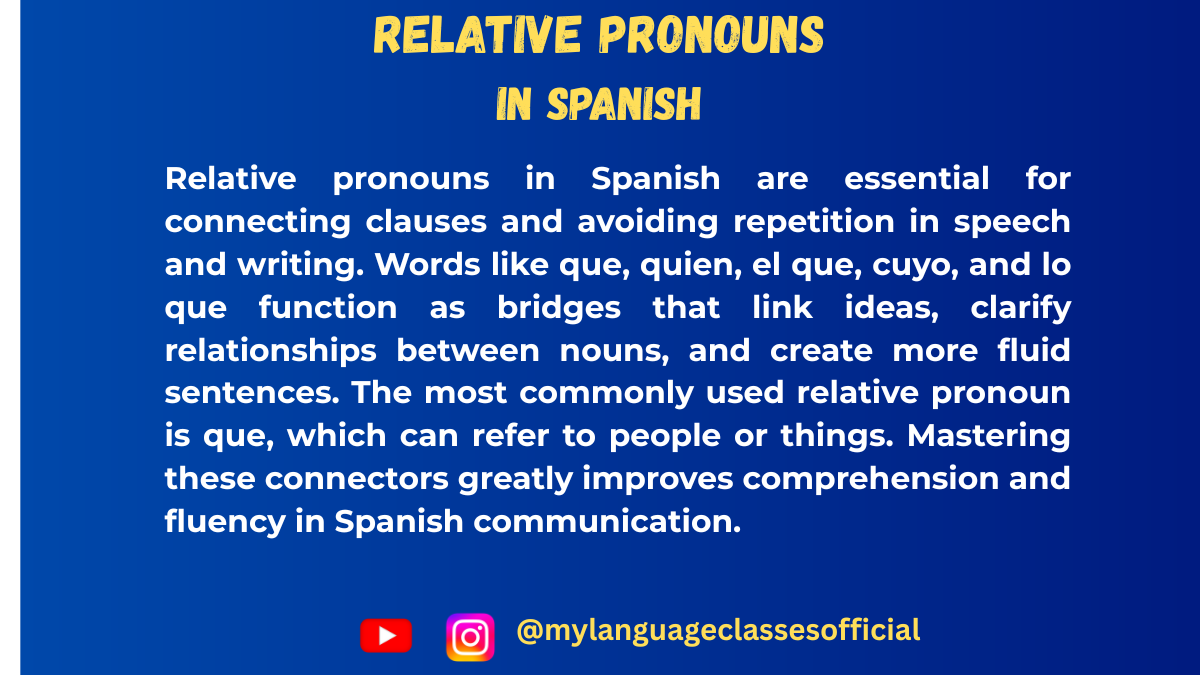
Relative Pronouns in Spanish
When learning Spanish, relative pronouns are essential for connecting sentences smoothly and making speech more fluid. These pronouns allow us to refer to people, places, or things without unnecessary repetition. In this blog post, we will explore the different relative pronouns in Spanish, their meanings, and how to use them correctly.
List of Relative Pronouns in Spanish
Relative pronouns in Spanish are used to introduce subordinate clauses and refer to a previously mentioned noun (antecedent). Below is a list of the most common relative pronouns, their meanings, and example sentences:
Relative Pronoun Meaning Example Sentence 1 Example Sentence 2 Que That, which, who La casa que compré es muy grande. La película que vimos fue interesante. Quien / Quienes Who, whom Mi amiga, quien vive en Madrid, me visitó ayer. Los estudiantes, quienes aprobaron, celebraron. Cuyo / Cuya / Cuyos / Cuyas Whose El hombre cuyo coche es rojo está aquí. La chica cuya madre es doctora es mi amiga. Donde Where La ciudad donde nací es hermosa. Este es el restaurante donde cenamos anoche. El que / La que / Los que / Las que The one(s) who/that El libro, el que compraste, es interesante. Las chicas, las que llegaron tarde, son mis amigas. El cual / La cual / Los cuales / Las cuales The one(s) who/that (formal) La casa en la cual crecí está en ruinas. Los estudiantes, los cuales fueron premiados, estaban felices. Lo que What, which No entiendo lo que dijiste. Lo que más me gusta es viajar. Lo cual Which (referring to a whole idea) Perdimos el tren, lo cual fue un problema. Llegó tarde, lo cual nos molestó mucho. Cuanto / Cuanta / Cuantos / Cuantas As much/many as Toma cuanto quieras. Cuantas veces lo intentó, falló. More Example Sentences
- La mujer que trabaja en la tienda es muy amable.
- Mi amigo, quien es muy inteligente, siempre me ayuda.
- El perro cuyo dueño es mi vecino es muy juguetón.
- No entiendo lo que está pasando.
- El país donde nací es hermoso.
- Los estudiantes, los cuales estudian mucho, sacaron buenas notas.
- La casa en la que crecí tiene muchos recuerdos.
- No sé lo que quieres decir.
- Las flores que compraste son muy bonitas.
- La ciudad donde vivo tiene muchas atracciones turísticas.
Things to Keep in Mind
- Agreement in Gender and Number:
- “Cuyo” agrees in gender and number with the noun it modifies: El hombre cuyos hijos estudian aquí…
- “El que, la que, los que, las que” also change according to the noun they refer to.
- Use of Articles:
- “El cual, la cual, los cuales, las cuales” often appear with a preposition and are more formal.
- “Lo que” and “lo cual” refer to entire ideas or situations.
- Que vs. Quien:
- “Que” is used for both people and objects.
- “Quien” is used mainly for people and must match singular or plural (quien/quienes).
- Where to Use Relative Pronouns:
- “Donde” is for places.
- “Lo que” and “lo cual” refer to abstract concepts.
- “Cuyo” means “whose” and agrees with the possessed noun.
Fill in the Blanks
- La chica _______ vive al lado es muy simpática.
- El perro _______ dueño es mi vecino ladra mucho.
- No entiendo _______ dices.
- La ciudad _______ naciste es hermosa.
- Mi amigo, _______ es doctor, trabaja en el hospital.
- Las flores, _______ compraste ayer, están muy bonitas.
- Juan, _______ hermano es mi compañero, me ayudó con la tarea.
- La razón por _______ llegamos tarde fue el tráfico.
- No sabía _______ querías decir.
- El edificio _______ ventanas son grandes es nuevo.
Answers
- que
- cuyo
- lo que
- donde
- quien
- las que
- cuyo
- la cual
- lo que
- cuyas
Conclusion
Mastering relative pronouns in Spanish is essential for improving fluency and making speech more natural. Understanding the gender, number agreement, and context in which each pronoun is used will help you construct sentences more accurately. Keep practicing with different sentence structures, and soon, using these pronouns will become second nature.
If you enjoyed this lesson, be sure to check out more posts like this on my blog at My Language Classes. Don’t forget to subscribe my YouTube channel and follow me on Instagram for the latest language learning tips and lessons. Leave a comment below to share your thoughts, or ask any questions you have.
Happy learning! 😊
📚 Continue Learning Spanish
-
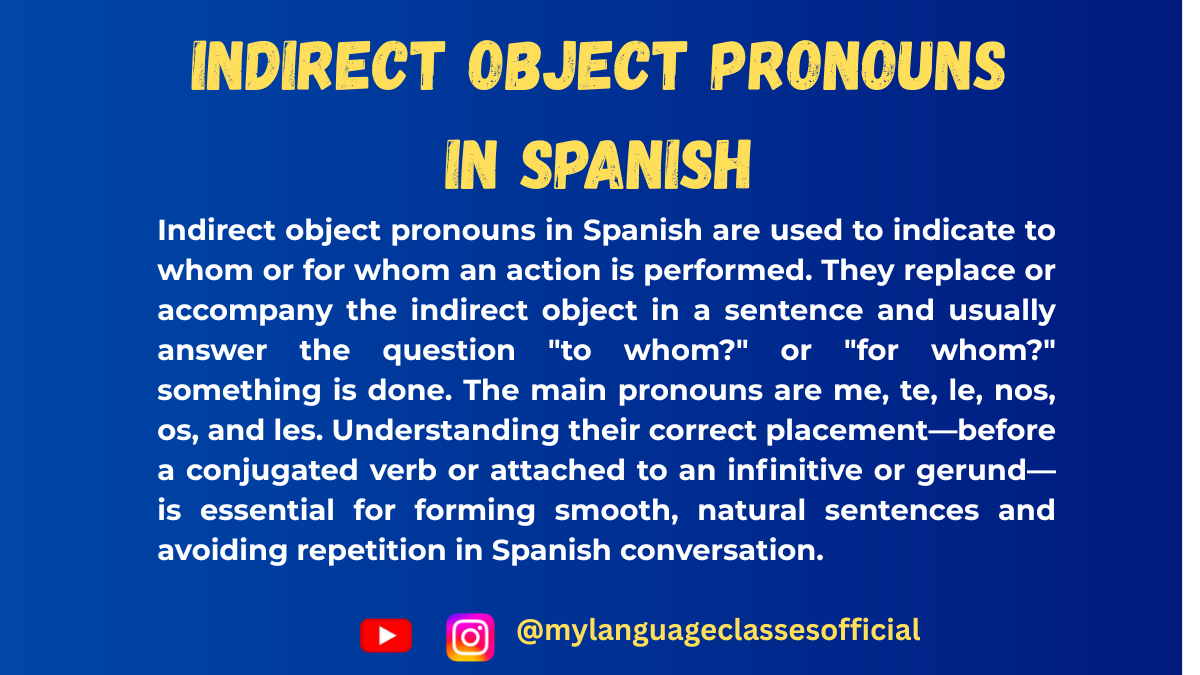
Indirect Object Pronouns in Spanish
Mastering Indirect Object Pronouns in Spanish
When learning Spanish, understanding indirect object pronouns (pronombres de objeto indirecto) is essential to achieving fluency. These little words pack a big punch, streamlining sentences and helping you sound more natural. In this blog post, we’ll dive into their forms, usage, and provide plenty of examples to solidify your understanding.
What Are Indirect Object Pronouns?
Indirect object pronouns answer the question “To whom?” or “For whom?” an action is performed. They replace the indirect object in a sentence, often saving time and avoiding repetition.
In English:
- He gave her the book.
The pronoun “her” replaces the indirect object (to whom the book was given).
In Spanish:
- Él le dio el libro.
The Indirect Object Pronouns in Spanish
Here are the indirect object pronouns in Spanish:
Pronoun English Equivalent me to/for me te to/for you (informal) le to/for him, her, you (formal) nos to/for us os to/for you (informal plural, used in Spain) les to/for them, you all
Placement of Indirect Object Pronouns
The placement of indirect object pronouns depends on the verb tense and type of verb construction.
1. Before a Conjugated Verb
The indirect object pronoun comes before a conjugated verb.
- María me dio un regalo.
(María gave me a gift.) - ¿Te mandaron la invitación?
(Did they send you the invitation?)
2. Attached to an Infinitive or Gerund
When there’s an infinitive (-ar, -er, -ir) or a gerund (-ando, -iendo), the pronoun can be attached to the verb or placed before the conjugated verb.
- Voy a contarte una historia.
(I’m going to tell you a story.) - Te voy a contar una historia.
(I’m going to tell you a story.) - Estamos escribiéndoles una carta.
(We’re writing them a letter.) - Les estamos escribiendo una carta.
(We’re writing them a letter.)
3. With Commands
- Affirmative commands: Attach the pronoun to the verb.
Dale el libro. (Give him the book.) - Negative commands: Place the pronoun before the verb.
No le des el libro. (Don’t give him the book.)
Indirect Object Pronouns with Clarification
Sometimes, indirect object pronouns like le and les can be ambiguous (they could refer to him, her, it, or them). To clarify, Spanish uses the preposition “a” followed by the indirect object.
- Él le dio un regalo a María.
(He gave a gift to María.)
Even when it’s clear, native speakers often include this redundancy for emphasis:
- A mí me encanta el chocolate.
(I love chocolate.)
The Double Object Pronoun Rule
In Spanish, you can use both a direct object pronoun and an indirect object pronoun in the same sentence. However, when both pronouns begin with “l” (le or les), the indirect object pronoun changes to se.
- Él le dio el libro a María. → Él se lo dio.
(He gave it to her.)
This rule avoids awkward repetition of sounds like “le lo”.
- ¿Les diste la carta? → ¿Se la diste?
(Did you give it to them?)
Practical Tips for Mastery
- Practice Common Verbs: Some verbs are frequently used with indirect object pronouns, such as dar (to give), decir (to say), preguntar (to ask), and gustar (to like).
Example:- ¿Me das tu número de teléfono? (Can you give me your phone number?)
- A ellos les gusta bailar. (They like dancing.)
- Immerse Yourself: Watch movies or read books in Spanish, paying attention to how these pronouns are used.
- Drill Sentence Structures: Write or say sentences with and without the pronouns to see the difference.
Exercises for Practice
- Rewrite the sentences using indirect object pronouns:
a) Yo di flores a mi mamá.
b) Estamos escribiendo una carta a nuestros amigos.
c) Juan va a dar el regalo a ti. - Translate into Spanish:
a) She told him the truth.
b) They bought us a souvenir.
c) I am going to explain the problem to you.
Final Thoughts
Mastering indirect object pronouns is a stepping stone toward fluency in Spanish. With practice and immersion, they’ll soon feel like second nature. Remember to focus on placement, usage rules, and practice as much as possible in real-life scenarios. ¡Buena suerte!
Have questions or want more practice? Drop them in the comments below!
If you found this guide helpful, I’d love to hear from you! Share your thoughts in the comments below or connect with me on social media. For more tips, resources, and inspiration, visit my blog at mylanguageclasses.in. Follow on Instagram and subscribe on YouTube
Master Spanish indirect object pronouns with rules, examples, and tips to speak more fluently and naturally. Simple guide for all learners.
- He gave her the book.


